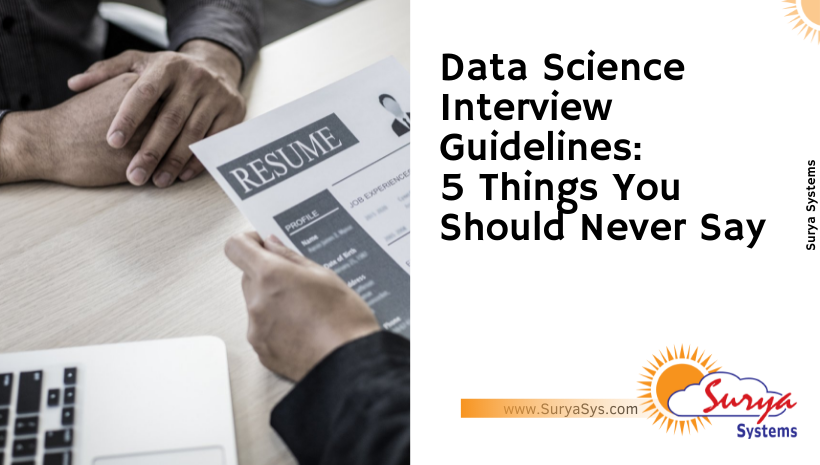- November 22, 2021
- Posted by: Sean Cooper
- Category: Technical Expertise

Data Science Interview Guidelines:
Interviews in data science can be a hassle and frustrating, but rejections are just the beginning. While a degree from an academic institution and relevant training, abilities, and courses work is crucial to entering the field of data science, they will not guarantee employment or satisfaction with the job.
When it comes to interviewing, there are many reasons for an organization to refuse an applicant. Of course, it’s more sense for a business to reject a qualified candidate instead of hiring a bad one. However, a highly skilled scientist in data science is the best of all the rest and must remain at the forefront of technology.
The hiring process for data scientists is unique compared to other areas. Candidates who are good in basic machine learning, statistics, and new-age programming languages can overcome a number of factors. For a data science recruitment to be successful, three main factors are a strong work ethic, a desire to learn, and a good attitude.
During a data science interview, several factors can cause disqualification, and this post will discuss how to avoid these issues.
Data science expert Venkat Raman, co-founder of Aryma Labs, shared in an earlier LinkedIn posting several scenarios that could lead to an applicant being rejected for stating these things, particularly when being interviewed by a skilled statistician or data scientist.
The Procedure of logistic regression is not a regression but rather a classification algorithm:
There are many misperceptions regarding logistic regression. Many researchers believe that regression within logistic regression is an oxymoron. Logistic regression is a method of analysis that can be utilized to determine regression, or in any other way, one could utilize it without setting an arbitrary cut-off point.
“Calling logistic regression a classification algorithm and believing it to be for ‘classification purpose only’ is akin to a person carrying a wheelbarrow on his head without even realizing that it can be rolled,” Raman said. Raman.
A ‘P-value’ is the probability that a result can be obtained by pure chance:
The authors of a research paper entitled ‘ Statistical tests, P values, confidence intervals and the power of a guide for misconceptions’ stress the importance of following spelled out analysis procedures to avoid small P values, even when the test hypothesis declared is accurate. It can also cause significant P values even when the hypothesis is incorrect.
The Null hypothesis is accepted:
“We often come across YouTube videos, blogs, posts, and private courses wherein, they say, we accept the null hypothesis instead of saying ‘we fail to reject the null hypothesis,'” said Raman. He stated that if you corrected the facts, they’d declare, what’s the major difference? — The opposite of rejecting the non-null” is accepting that null.
Similarly, Raman said it’s not as simple as it seems, and we must be able to see beyond this and comprehend one key concept — Popperian falsification. This concept explains why we use the phrase “failure to reject the null.”
It is believed that the Popperian Falsification implies that science is never settled; it is constantly evolving or changing. That is, science-based theories that are considered to be sacrosanct today could be disproved in the future. So, in this way, scientists do not proclaim that X theory is correct; instead, they attempt to prove that “theory X is false. It’s a falsification. This is where the concept of “we fail to disprove the null’ enters play.
If we accept the null hypothesis, we cannot establish that theory X is not valid. “But, does that mean ‘theory X is correct?’ No, somebody smarter in the future could prove theory X is wrong,” declared Raman. There is always the possibility of that happening.
Regression using stepwise methods:
Stepwise regression is an iterative process of building the stepwise regression model, which involves choosing independent variables in the final model. It usually involves removing or adding explanation variables over time and evaluating their statistical significance at the end of each.
Models are tested on the data, and you choose one based on an accuracy metric using a low coding library:
If you test every model in blind faith and then pick one based on certain precision metrics, Raman said that you’re not doing data science. You are simply playing the system.
He also said that If you weren’t sure of the correct variables to use in your model, you’d not know even after having some variables from the ML/stat feature selection process. “Just that you would falsely convince yourself that ‘these features that you have gotten are important'” he said.
He also said that applying data science to your business is a serious field that requires us to be aware of what we’re doing. Understanding the basics of math and statistics can help. “We aren’t necessarily scientists in the strictest sense. “But, at least to do justice to the word ‘science’ in data science,” Raman said. Raman in a suggestion for the following method:
- One must think of and consider the issues deeply.
- Select features based on the domain expertise (or speak to experts in the field before making a decision).
- Be aware of how models function under the hood.
- Be aware of the advantages and disadvantages of using an algorithm or technique to information.
“AI could become an industry worth billions of dollars or even a trillion-dollar business, but only when the data science is done correctly. If it is not done correctly, it will result in discontent and less acceptance,” Raman said. Raman.
Concluding:
In addition to the above, experts say other things could make you unqualified for an interview in data science. As stated by Health IQ VP – product management Praful Krishna Some of them are:
- Inability to display the technical inclination of one’s mind on paper.
- Inability to solve basic equations or solve puzzles, and so on.
- Inability to comprehend fundamental statistical concepts such as Naive Bayes.
- Inability to be proactive in the scenarios that pose problems about calculations and methods that are redundant.
- Inability to communicate with the interviewer, possibly due to the ego or aggressive personality of the applicant.
A failure to comprehend how to analyze quality data could also result in a rejection. Expert in technology Allen Woods said there is only one constant: garbage in garbage out (GIGO). If people aren’t aware of the significance of that, all analysis techniques worldwide are nothing, he stated.
“So one of the key questions is what actions do you follow to verify and validate your data, and in the process, how do you identify and address any shortcomings within the boundary of the observation? And if a component of the solution to shortfalls in observation is the introduction of new data formats, What would be the effect in terms of the coverage, in the case of graph schemas in terms of its shape? It’s not only about the statistical method,” said Woods.
